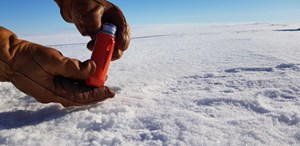Energy seismic technology deployed in Antarctica ahead of potential use on distant icy moons
Scientists have deployed a network of seismometers onto Antarctica’s Brunt Ice Shelf in an experiment which will test the ability of the instruments to operate on icy moons of the Solar System.
Twenty state-of-the-art seismic ‘Nodes’ built by STRYDE (the world’s smallest and lightest land seismometers) have been deployed onto the ice shelf around the British Antarctic Survey (BAS) Halley VI Research Station, along with one ‘short period’ (SP) sensor built by Imperial College London and the University of Oxford and funded in development with the UK Space Agency. This is the first time that either of these instruments have been used in Antarctica, an environment which is the closest analogue of an icy moon found anywhere on Earth.
In addition to laying the groundwork for future space science missions, this exciting and novel experiment will also help to understand the floating ice shelf upon which the BAS Halley VI Research Station is located. The team behind the study have already started to gather useful data on seismic vibrations recorded in the ice shelf, which may help to further illuminate the evolution of cracks in the shelf and ocean conditions beneath. This data will contribute towards understanding the changing nature of the Brunt Ice Shelf which is critical to planning future Antarctic operations.
Similar SP sensors are currently recording data on Mars as part of the NASA InSight mission and a further set will be sent to the Moon as part of the NASA Farside Seismic Suite in 2024. The hope is that seismometers such as these will one day be sent to the icy moons of Saturn or Jupiter, where seismological recordings will be one element of data acquisition used to explore the moons' interiors, and to establish whether conditions exist where primitive life may have evolved. This project will test the ability of seismic instruments to perform in an environment similar to that found on these icy moons for the first time, and in doing so will play a key role in the search for life elsewhere in the Solar System.
The Nodes were deployed in mid-January, and commissioning of the SP sensor was completed at the end of January 2022. The first Antarctic deployment is expected to last 2-3 weeks, ahead of a potential longer deployment next year. The project is a partnership between BAS, the UK Space Agency, University of Oxford, and STRYDE.
“This is an incredibly exciting opportunity to test the seismometers in one of the most extreme environments on Earth, and a valuable opportunity to explore how they might perform on one of the icy moons of Saturn or Jupiter one day,” said Ben Fernando, co-lead on the project at the University of Oxford.
Seismic instrumentation and data are extremely sensitive to a large range of ground motions and can therefore aid in monitoring ice dynamics, which is crucial for climate change, in such vast, remote places as Antarctica, said Tarje Nissen-Meyer, co-lead on the project at the University of Oxford.
“Halley is a great platform to test autonomous instrumentation that may be deployed in other harsh environments elsewhere on Earth, or indeed the Solar System,” said Thomas Barningham, Halley VI Research Station Science Coordinator. “Locally, the data may prove to be a useful compliment to the enormous amount of data we collect from various instruments that monitor the ice shelf. Such data may pave the way for more intensive ice shelf seismic campaigns in the future.”
The UK is playing a leading role in space science and exploration, developing advanced technologies capable of performing in the harsh conditions found on distant worlds, said Sue Horne, Head of Space Exploration at the UK Space Agency.
“This project will help prepare for future missions to the moons of Saturn and Jupiter, while using instruments first designed for Mars to monitor the formation of cracks in the Antarctic ice. It’s an excellent example of how space technology is providing benefits here on Earth,” Horne said.
STRYDE is proud to play a role in advancing science through this experiment which will aid future efforts in the search for life elsewhere, STRYDE CEO Mike Popham said.



